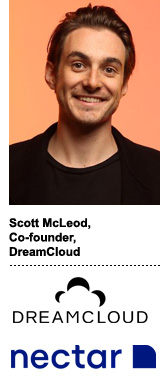
There’s no rest for direct-to-consumer mattress marketers.
“We’re constantly running tests,” said Scott McLeod, co-founder of DreamCloud, a mattress startup housed under Nectar Home, parent company to a growing portfolio of DTC sleep and home furnishing brands, including Nectar Sleep and ecommerce rug brand Wovenly.
“We have disdain for the idea of running something without measurement to make sure it’s working,” McLeod said.
Nectar Sleep applies the same rigorous testing philosophy to its video marketing efforts, which are becoming an increasingly important part of the mix. Over the course of 2018, Nectar released a series of videos on YouTube – direct response ads in disguise – that racked up millions of views, including one starring Big Bang Theory star Mayim Bialik and another featuring weirdly cute CGI versions of Donald Trump and Kim Jong Un’s brains dancing. (Just watch it.)
“If your content isn’t engaging, no one is going to remember you,” McLeod said. “This is a very long buying cycle, so you need to establish relationships, and you can do that with storytelling. This type of content marketing is only going to be more and more important – you can’t just stuff ads in everyone’s face everywhere.”
Nectar Home has done more than $300 million in annual revenue since the company was founded in 2016.
AdExchanger spoke with McLeod about the need for rigorous testing, why Nectar doesn’t work with agencies and how many terrible vendor pitches he gets in a day.
AdExchanger: Nectar Sleep is really hot on video, which is true for a lot of the DTC mattress startups. Why is that?
SCOTT MCLEOD: We’re not even trying to sell mattresses with video, actually. Content is the most top-of-the-funnel activity you can do, so we focus on building awareness about sleep health and mattresses to build trust around our brand.
Video is working for a lot of categories right now, because all channels support video and video supplements an increase in time on page, in app and on site.
That said, it’s not easy to get video right. It’s much harder to test 55 videos than it is to test 55 photos over the course of a few weeks.
How would you describe your digital marketing strategy?
Everything needs to be measurable and everything needs to be tested against a hypothesis. That’s how we approach any new marketing channel, and we use the results to help us figure out how to allocate budget. We also have our own internal attribution solutions that help us guide our marketing strategy week over week and quarter over quarter.
We’re heavily invested in digital – everything from Facebook to AdWords to Pinterest, Twitter and Bing – because it’s measurable.
How do you approach testing?
When we’re looking at a new channel, we set aside enough budget so that it’s a serious test, but we also try and figure out what is the least amount we can spend to get a gauge of whether something is successful. We also test multiple variations of creative and audience targeting. If you don’t, then it’s not fair to say that a channel does or doesn’t work.
And because mattresses and furniture have a longer buying cycle, we also have to consider time, as in how much time do you give the channel to perform. Our testing periods usually run between 30 and 90 days.
 What metrics are you tracking?
What metrics are you tracking?
We usually look at in-funnel engagement metrics as a means of understanding purchase intent: CTR, CPC, impressions. These things matter for us, but, ultimately, what we really care about is whether we reached an engaged visitor and how that person interacted with the website, our marketing funnel and our assets.
How much marketing-related work do you do in house?
We’ve internalized all of our marketing from the very beginning. The only thing we do externally is work with a creative agency for photo and video shoots. We have a dedicated creative team in house. We never hired agencies from day one.
Why no agencies?
We want everything we do to be measured and agencies are never able to perform for us, because they only focus on one function. When we test, we want to test the whole effort and many different teams need to communicate for that to happen.
So, you’re handling programmatic media buying in house, too?
We have an internal programmatic team. Not a lot of people are building internal programmatic teams, but we did, because that is what you need to really advantage a digital marketing strategy.
But you do work with some third-party technology partners. How do you vet them?
We test vendors that can help drive traffic for us on top of our own technology. Do they have some proprietary algorithm or a new way to target? Then we’re interested. We do a 30 to 90-day test and, if there’s success, it ends up being a relationship.
We end up actually working with maybe one out of every six vendors we test, and I probably get 30 emails a week from vendors claiming to have exactly the thing I need. I couldn’t even tell you the number of stupid things that come into my inbox.
This post was syndicated from Ad Exchanger.


More Stories
EssenceMediacom’s should’ve gone to Specsavers moment with new OOH ad
A Teddy Bear’s Dreams Are Dashed in Sandy Hook Promise’s Gut-Punching Ad
Secret Sounds Connect rebrand new chapter in agency’s evolution